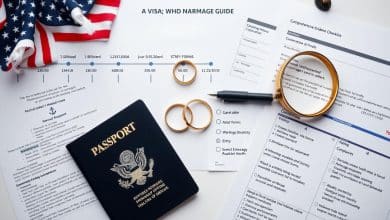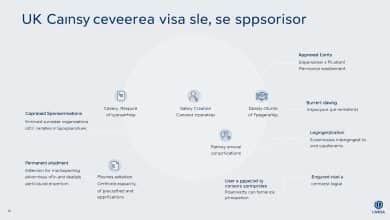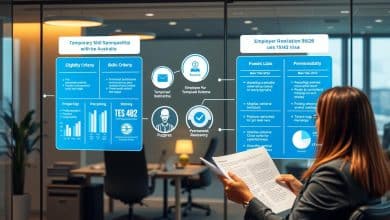Navigating Australian Visa Sponsorship: Expert Tips on Finding Employers and Meeting Skill Demands
The Australian visa sponsorship world is full of challenges and chances for skilled workers.
Fields like healthcare, engineering, IT, and education are facing big skill gaps. Knowing about the employer nomination scheme and the skilled occupation list is key for visa hopefuls.
This article offers vital tips on Australian Visa Sponsorship. It explains how to tackle this complex journey. You’ll learn about the points system and why it’s important to find a sponsor and show off your skills. Getting a job in Australia often means making the right job applications, networking, and understanding visa rules.
Understanding Australian Visa Sponsorship
Australian visa sponsorship is a key way for skilled workers from abroad to find jobs in Australia. Employers in Australia can help these workers by offering visa options that match their skills and the job market’s needs. Knowing about the different visa sponsorship types can help applicants choose the best option for them.
What is Visa Sponsorship?
Visa sponsorship means an Australian employer agrees to support a skilled worker’s visa application. This lets the employer fill jobs that locals can’t do. The worker gets valuable work experience and a chance for more immigration opportunities. Getting a sponsorship visa can lead to a new life in Australia.
Types of Visa Sponsorship
There are many visa sponsorship types, each for different jobs and stays. Some common ones are:
- Temporary Skilled Shortage (Subclass 482): This visa lets skilled workers work in Australia for up to four years, based on their job and where they’re from.
- Employer Nominated Scheme (Subclass 186): This offers permanent residency to workers who’ve been with the same employer for at least two years.
- Skilled Employer Sponsored Regional (Subclass 494): This visa lets workers live and work in certain areas of Australia for up to five years, with employer support.
- Designated Area Migration Agreement (DAMA): A special way for states to tackle specific labor shortages with custom agreements.
Benefits of Visa Sponsorship for Applicants
Getting visa sponsorship has many benefits beyond just a job. Some key advantages are:
- Access to a wide range of job opportunities across different sectors.
- The chance to move towards permanent residency through various sponsorship visas.
- More career growth and professional development in a lively work setting.
- Greater community integration and the chance to build a life in Australia.
The Role of Employers in Sponsorship
In Australia, employers are key in bringing skilled workers from abroad. They help fill labor gaps. It’s important for businesses to know how sponsorship works. They must follow visa rules and show they really need these workers.
What Employers Need to Know
Before getting sponsorship, companies need to learn a few things:
- They must be approved as a Standard Business Sponsor (SBS) by the Australian government.
- They need to show they can’t find local talent for the job.
- They must follow Australian immigration laws and workplace rules.
- They need to prove their business is stable financially.
- Applicants must speak English well and pass health and character checks.
How Employers Benefit from Sponsorship
Employer sponsorship helps businesses grow by bringing in skilled workers. The benefits include:
- They can fill important job gaps in areas like healthcare and tech.
- They get talented people who bring new ideas.
- They can sponsor many employees with one approval, valid for five years.
- It makes their company more attractive to future talent.
This approach gives Australian companies a competitive edge. It helps them stay innovative and productive in the global market.
Identifying In-Demand Skills and Professions
Professionals looking to get sponsored in Australia need to know what skills are in demand. Knowing these in-demand skills Australia can really help them find a job and get sponsorship. There are many resources that can guide them on which jobs are most wanted.
Resources for Skill Demand Research
The skilled occupation list is a key tool for finding out which jobs are top priorities in Australia. This list changes often to keep up with the job market and new trends. To research skill demand, you can use:
- Government publications detailing occupation shortages
- Industry reports and workforce analyses
- Job market forecasting studies from reputable organizations
Industries with High Demand for Workers
Some industries in Australia always need skilled workers, making them great for job seekers. These include:
- Healthcare – with roles such as physicians, nurses, and allied health professionals
- Information Technology – including software developers, cybersecurity experts, and data analysts
- Engineering – offering chances for civil, mechanical, and electrical engineers
- Skilled Trades – such as electricians, plumbers, and carpenters
By aiming for these high demand professions, people can match their career goals with what the market needs. This makes them more appealing to employers. With the new Skills in Demand Visa coming in 2024, it’s more important than ever to keep up with these skills.
How to Find Sponsors in Australia
Finding sponsors in Australia requires job seekers to be strategic. They need to navigate the complex job market. Networking, online job portals, and recruitment agencies are key to finding sponsorship opportunities. By using these methods, candidates can better connect with potential employers.
Networking Strategies for Job Seekers
Building a strong professional network is crucial. Job seekers can explore different ways to do this, such as:
- Attending industry conferences and seminars to meet influential figures.
- Joining professional organizations related to their field for insights and resources.
- Leveraging social media platforms like LinkedIn to connect with potential employers.
Consistent engagement and showcasing relevant skills can make candidates stand out.
Online Job Portals and Resources
Online job portals are essential for job seekers. Platforms like SEEK, Indeed, and Jora list many job openings with sponsorship options. These sites allow filtering for roles open to international applicants, making sponsorships more visible.
Many positions requiring the Temporary Skill Shortage Visa (TSS) are also listed. This makes these websites very valuable in the search process.
Utilizing Recruitment Agencies
Working with recruitment agencies can make the job search easier. Agencies that specialize in overseas placements connect candidates with employers willing to sponsor visas. They have relationships with companies needing to fill skill shortages, matching candidates with job openings.
By using these agencies, individuals can increase their chances of finding sponsorship opportunities.
Crafting a Compelling Resume and Cover Letter
Making a standout resume and cover letter is key for job seekers in Australia. You need to show your skills, qualifications, and experiences clearly. It’s important to follow local formatting rules.
Key Elements of an Effective Resume
An effective resume in Australia is usually two to four pages long. It follows a chronological order. Key elements include:
- Contact Information: Clearly display your name, phone number, and email address at the top.
- Professional Summary: Include a brief overview of your skills and qualifications relevant to the job you are applying for.
- Work Experience: List your work experience in reverse chronological order, emphasizing job titles, responsibilities, and accomplishments.
- Education: Mention your educational qualifications, including the institutions attended and degrees obtained.
- Skills: Highlight specific skills that match the requirements of the role, emphasizing those that are particularly valued in the Australian job market.
Using industry-appropriate terminology in your resume can boost your chances of getting interviews.
Cover Letter Tips for Visa Sponsorship
A compelling cover letter is crucial to grab the attention of potential employers. Important aspects include:>
- Personalization: Address the letter to a specific person whenever possible. Mention the role you are applying for and the need for visa sponsorship.
- Value Proposition: Clearly outline what you bring to the position, emphasizing relevant skills and experiences that make you an ideal candidate.
- Tailored Applications: Adjust your cover letter according to the industry and company you’re applying to, showcasing an understanding of their needs.
By focusing on these elements, applicants can create tailored applications that resonate with Australian employers. This makes a strong case for their candidacy in a competitive job market.
Preparing for the Job Interview
Getting ready for a job interview is key for those seeking sponsorship in Australia. Knowing how to act in an Australian interview can really help. Being professional, clear, and open can make a big difference.
Common Interview Questions
Interviewers ask many questions to check if you’re right for the job. Knowing these questions is important. You might be asked:
- What are your reasons for travel to Australia?
- Why did you choose this specific university or job opportunity?
- What is your plan after your visa expires?
- How do you intend to finance your stay?
- Do you have any family or friends in Australia?
Practicing these questions can really boost your chances. Many people feel more confident after practicing.
Showcasing Your Skills and Experience
It’s important to show off your skills and experience in the interview. Give clear answers that highlight your qualifications. Here are some tips:
- Prepare documents to show you can afford to live in Australia.
- Be ready to talk about your long-term plans in Australia.
- Double-check your visa application to avoid mistakes.
- Dress well and show a positive attitude.
Visa interviews check if you’re serious and safe for the country. Officers look at your skills, money, and documents. Being well-prepared and knowing the rules can help you seem confident and real.
Understanding the Visa Application Process
Applying for a visa in Australia can be tough for many. Knowing the steps and common mistakes helps make it easier. This guide will help you through the visa application process and show you how to avoid mistakes for a successful application.
Step-by-Step Visa Application Guide
The visa application process has several key steps:
- Research visa options: Find the right visa for your skills and work plans in Australia. This could be the Temporary Skill Shortage (TSS) visa or other employer-sponsored visas.
- Gather documentation: Get all needed documents like your passport, statement of purpose, sponsor’s letter, and proof of qualifications.
- Meet eligibility criteria: Check if you meet age limits, skills assessment, and health requirements set by Australian authorities.
- Complete the application: Fill out forms carefully to avoid mistakes. Incomplete applications can cause delays or rejections.
- Submit your application: Send your application and all documents early, before your planned travel date.
Common Mistakes to Avoid
Many applicants face problems that can harm their chances. Knowing these common mistakes is key:
- Incomplete applications: Not filling out all sections or missing documents causes big delays.
- Misrepresentation: Giving false information can get your application denied right away.
- Overlooking health and character checks: Not showing health insurance or background checks can slow down approval.
- Late applications: Applying too late can cause a lot of stress.
By following this guide and watching out for common mistakes, you can improve your chances of getting a visa in Australia. Getting help from immigration experts can also be very helpful for specific issues and to make the process smoother.
Benefits of Professional Networking
In today’s job market, networking is key. It helps a lot when you’re looking for a job in Australia with visa sponsorship. Making connections in your field can open doors to jobs you might not find elsewhere. It’s not just about meeting people; it’s about building relationships that can lead to jobs and sponsorship.
Building Connections in Your Industry
Strong connections with industry pros can really help. People who network well often find jobs that others don’t. These connections can also be mentors, helping you find your way in your career. By going to events and joining local groups, you can grow your network and get noticed.
Leveraging Social Media for Networking
Social media, especially LinkedIn, is a must for networking today. It lets you connect with recruiters and others in your field. A good LinkedIn profile shows off your skills and achievements, making you more attractive to sponsors. By joining in on discussions and sharing useful content, you can find opportunities you didn’t know existed.
Staying Informed on Immigration Policies
For those looking to get sponsored in Australia, keeping up with immigration policy is key. Visa rules change often, thanks to government actions. The Australian Government Department of Home Affairs is a great place to find updates. They share news on new visa programs, like the MATES visa, aimed at skilled workers from places like India.
Resources for Keeping Up with Policy Changes
There are many visa policy resources to help track changes. It’s smart to check government sites, professional groups, and talk to immigration experts. They can tell you how new rules might help or hurt your chances of getting sponsored.
For example, new rules about domestic violence and exemptions for kids born in Australia can change things. It’s important to know about these updates.
How Changes Can Affect Your Sponsorship Opportunities
It’s crucial to understand how policy changes affect your sponsorship chances. For example, new rules for state sponsorship can open doors in certain fields. Knowing about the Temporary Skill Shortage (TSS) visa is also key. It can lead to permanent residency after four years.
By staying informed, you can plan better. This way, you can follow the rules and increase your chances of getting sponsored.
For more information explore the official visa website mentioned in this article:
You will be redirected to another website
FAQ
What is visa sponsorship in Australia?
Visa sponsorship lets Australian employers help skilled workers from abroad. They do this through visas like Subclass 482, Subclass 186, and Subclass 494.
What types of visa sponsorship are available for skilled workers?
Skilled workers can get sponsorship through Subclass 482 (Temporary Skill Shortage), Subclass 186 (Employer Nominated Scheme), and Subclass 494 (Skilled Employer-Sponsored Regional).
What are the benefits of receiving visa sponsorship?
Getting visa sponsorship opens up job chances. It also offers paths to permanent residency and career growth.
What must employers demonstrate to sponsor a worker?
Employers need to show they really need the worker for the job. They must follow visa rules, like labor market testing and ongoing compliance.
How can one identify in-demand skills in Australia?
To find in-demand skills, check the Skilled Occupation List and industry reports. Look for areas like healthcare, IT, engineering, and skilled trades.
What strategies can job seekers use to find Australian employers willing to provide sponsorship?
Job seekers can network on LinkedIn, use job sites like SEEK and Indeed, and work with recruitment agencies for overseas jobs.
What should be included in a resume for the Australian job market?
A resume should highlight relevant skills, qualifications, and experience. It should be 2-3 pages long, following local formatting standards.
How should candidates prepare for job interviews in Australia?
Candidates should know common interview questions and practice their answers. They should also understand Australian interview etiquette, focusing on professionalism and clear communication.
What are the steps in the visa application process?
The visa application process starts with gathering documents and submitting applications. It’s important to avoid mistakes like incomplete applications or not meeting criteria.
How can professional networking benefit job seekers?
Networking can lead to job opportunities and sponsorship. It connects candidates with industry professionals and reveals hidden job markets on platforms like LinkedIn.
Why is it important to stay informed about immigration policy changes?
Keeping up with immigration policy updates is crucial. Changes from the Australian Government Department of Home Affairs can affect visa sponsorship. Candidates need to adjust their strategies accordingly.
Published on: 28 de November de 2024

Abiade Martin
Abiade Martin, author of WallStreetBusiness.blog, is a mathematics graduate with a specialization in financial markets. Known for his love of pets and his passion for sharing knowledge, Abiade created the site to provide valuable insights into the complexities of the financial world. His approachable style and dedication to helping others make informed financial decisions make his work accessible to all, whether they're new to finance or seasoned investors.






